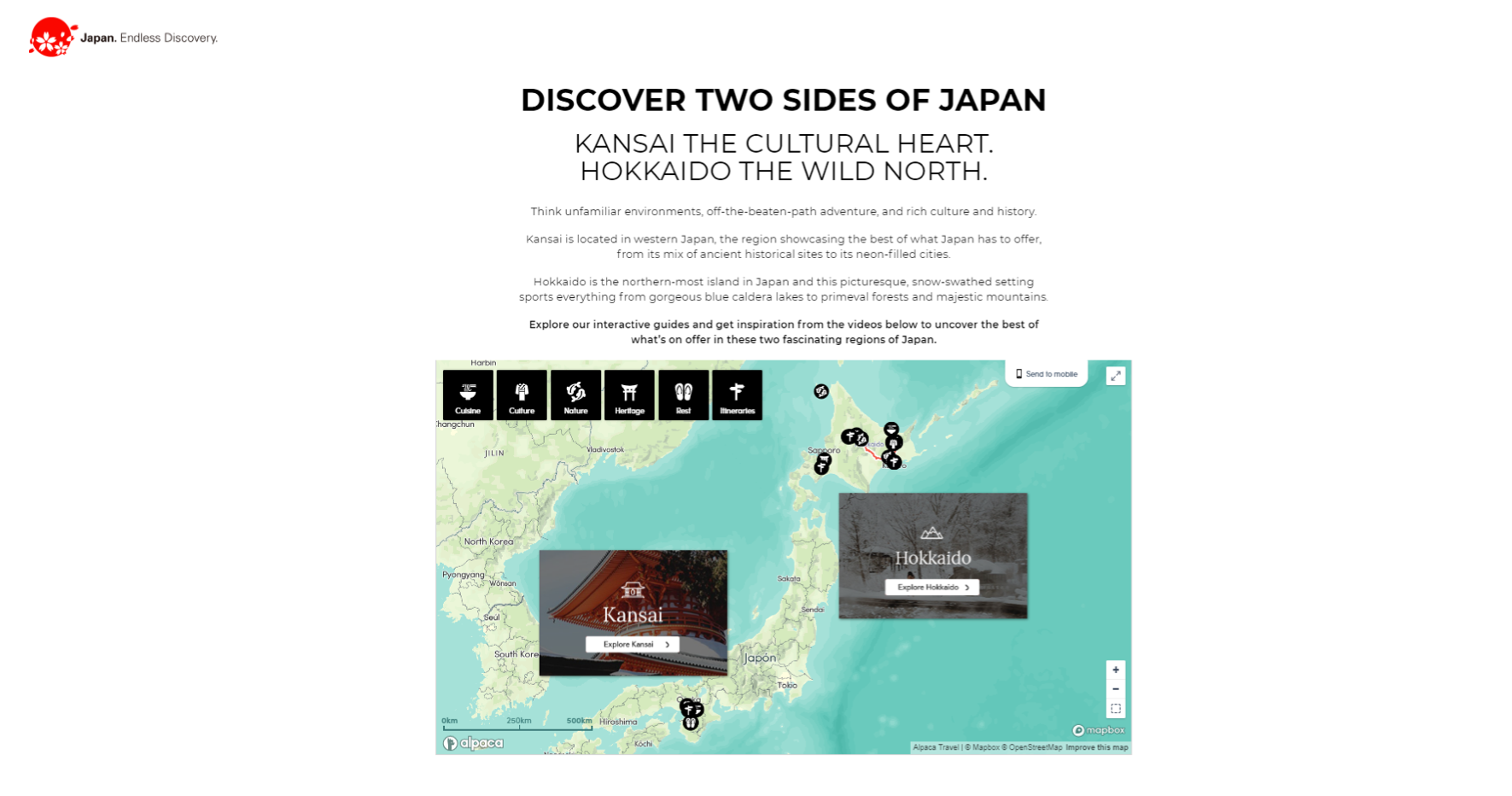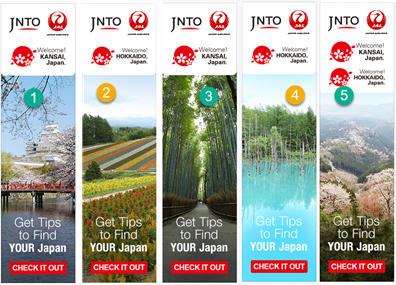JNTO “Influences” Recovery
As Japan became one of the most popular travel destinations for Australians, the nation’s tourism board shifted its in-market strategy from brand awareness to tourism dispersal. This shift was accelerated thanks to an integrated Australian marketing campaign following a tragic pair of earthquakes in Kansai and Hokkaido.
Gate 7’s approach to content creation and distribution—combined with an understanding of the client’s guiding principles—drove an impactful campaign built on visually stunning, cost-effective social media content.
Background and Challenge
Over the past five years, Australian tourism to Japan has exploded, with the destination last year becoming the seventh most popular spot for travellers from Down Under. Given this growth in visitation, Japan National Tourism Organization (JNTO), the national tourism board, shifted their in-market strategy from promoting broad destination awareness to encouraging dispersal to avoid over-tourism of Tokyo and other main cities which captured the lion’s share of visitors.
This move from destination awareness to dispersal messaging was rapidly accelerated following tragic earthquakes that struck the regions of Kansai and the northern island of Hokkaido. In the aftermath, JNTO released funding to assist the areas with tourism recovery and promotion, and in Australia, these funds were earmarked for content and cooperative marketing campaigns.
Gate 7 had already proven themselves adept partners in conceptualising and executing integrated content and trade campaigns for JNTO through their work on a MasterChef broadcast integration and culinary activation campaign. Following an open tender for the new funds, the team was once again selected to bring a creative content concept to life that would encourage visitation to help restore both recovering regions.
Strategy and Solution
The Gate 7 team already enjoyed strong destination knowledge given their previous work with JNTO and was well versed in the core values that underpin the client’s activities. This included the concept of “wabi-sabi”, the importance of acceptance, and a commitment to the everyday, in Japanese culture. More importantly, they had proven experience in tourism dispersal campaigns including successful campaign deployment for notable clients like Brand USA and Visit California – both mature clients in the market who emphasised “beyond gateway” messaging to Australian and Kiwis.
The two regions highlighted in the campaign were both relatively well-known; Kansai thanks to its major cities of Osaka and Kyoto, and Hokkaido due to very popular ski fields around Niseko. However, JNTO was looking to highlight the regions in a wider scope. Our team capitalised on each region’s unique experiences and character to guide the strategic creation of content for the campaign.
Kansai
Kansai, west of Tokyo, is often seen as a spiritual centre, as well as a hive of traditional Japanese culture, art, and architecture—all encapsulated in serene natural surroundings.
Hokkaido
Hokkaido, on the other hand, is the home of outdoor adventure, and the client aimed to showcase the snowy areas without highlighting skiing, due to tourism saturation of the region’s ski fields.
The resulting integrated campaign was comprised of four interlinked programs, each targeting a number of demographics and consumers in various phases of the purchase cycle. The campaign fully leveraged Gate 7’s “create once, publish often” mentality to maximise available budget and ensure all content assets were designed to be re-edited, reused, and repurposed across as many tactical elements as possible, both within the campaign, and in broader work.
Each program drove traffic to a Gate 7-operated microsite with additional information and a content-rich interactive map produced by local agency Alpaca. The map gave geographic context to each piece of content, alongside archived JNTO information and travel tips.

Content Creation
Content creators and social media influencers, Little Grey Box, and Sophie Chan, were engaged to travel the regions while capturing video and still imagery. They were accompanied by a freelance videographer who secured additional content to both supplement capacity and produce cost-effective premium marketing content. Little Grey Box and Sophie produced travel guides and narrative content for their own (and the JNTO-operated Visit Japan AU) channels. These, and six Gate 7-produced pieces – including cut-downs – were repackaged to form the foundation for the other three tactical elements of the campaign.
The Gate 7 team oversaw and organised itinerary development, storyboarding, scriptwriting, briefing, production, key messaging, and post-production for the familiarisation trip while collaborating with JNTO on cultural sensitivities and preferred narrative highlights. The content was designed to be visually appealing and light in a narrative to ensure it could be easily repurposed into other mediums and stories within the campaign.
Cooperative Marketing Campaign

To connect discovery with dispersal by providing viewers with a bookable call-to-action, the Gate 7 team partnered with online retailer, Expedia, and Japan Airlines for a cooperative destination trade campaign. Whenever deals for Japanese destinations were searched, banner advertising and in-line sponsored deals were displayed to consumers. These banner ads and sponsored deals were populated with content produced by the influencers on the content creation trip and were largely built out by the Gate 7 team.
Native Content Partnerships
The influencer trip content also provided the foundation for several pieces of narrative content that were distributed through culinary and culture publication Broadsheet. These first-person cultural narratives focused on Australians (or locals with a connection with Australia) who lived in either Kansai or Hokkaido. Examples included a chef from Hokkaido who worked in Australia for over a decade and an Australian who had moved to Osaka to open a gourmet burger shop in 2016.

Wendy Wu Tours, a local guided tour company specialising in Asian destinations, joined the Broadsheet campaign as an additional trade call-to-action, reducing the campaign costs for each partner, and further integrating travel trade opportunities into the content. In addition to the trade integration, Wendy Wu Tours and Broadsheet provided prizing for, and ran, a consumer competition with winners heading to Kansai and Hokkaido, to further promote the regions.
Millennials, a key demographic for JNTO, were targeted directly with additional long-form narrative content through the youth-oriented travel publication AWOL. This travel guide content highlighted both regions, and thanks to AWOL’s then-partnership with Qantas, further integrated trade components into the campaign.
Results and Learnings
The entire campaign, which was conceptualised and executed in six months, proved to be quite successful for all parties involved.
The separate but interlinked programs laddered up to an overall incredibly successful campaign promoting the two regions. Each messaging pillar, targeting a different demographic, managed to push the boundaries on the platform or publication that it lived on, and producing one set of cost-effective content for use across the entire campaign created cohesive messaging, and kept campaign budgets to a minimum.
The Expedia and JAL campaign received 558,000 unique visitors monthly, and generated 26.6% YoY growth for the regions, resulting in a 31.5:1 return on advertising spend through the retailer. The Broadsheet and Wendy Wu Tours campaign had over 50,000 page views (making it the to-then biggest content piece for 2019) and received over 12,000 competition entrants, two-thirds of which opted-in for a consumer database. This content passed nearly 2,400 unique viewers onto Wendy Wu Tours’ site, generating over 100 product enquiries.
AWOL’s one content piece generated over 20,000 page views with 3:37 average time on page, and reached nearly 170,000 social media users, with just two posts. In total, across two YouTube videos, 15 Instagram stories, 28 social media posts, and one blog, the content creators reached 74,127 followers through their channels alone. 1,500 unique users also accessed the JNTO-managed content hub, showing the value of contextualising the information.
The results were not only a boon for JNTO and the promoted region; the relationship between Gate 7 and the client was further solidified, which led to additional campaigns and representation as the latter looked to boost Japan’s brand awareness in, and visitation from, New Zealand.

